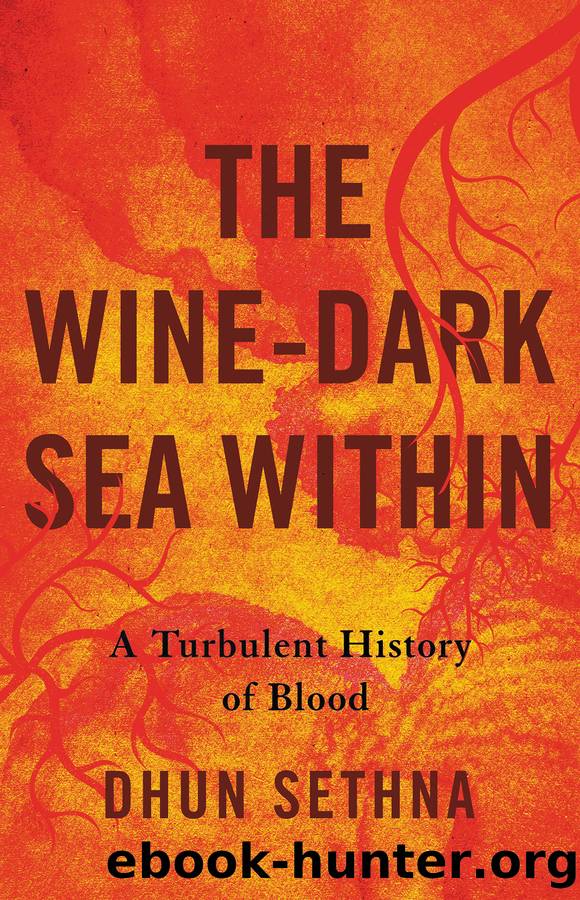The Wine-Dark Sea Within by Dr. Dhun Sethna

Author:Dr. Dhun Sethna [H., Dhun Sethna]
Language: eng
Format: epub
ISBN: 9781541600669
Publisher: Basic Books
Published: 2022-06-07T00:00:00+00:00
A physical circulation of blood was not something that was directly visible. It was conceptual: a circle was a symbol that ended at the point at which it began, and Harvey realized that he had to make his argument for a circulation cogent. It was an instance when it was necessary to make an immense leap between observed facts and the secrets they concealed. It was here that he hopped off the Galenic bandwagon and advanced into territory few in the biological sciences had claimed before, by thinking in terms of quantification. Galileo was teaching mathematics at Padua during Harveyâs student days, and it is highly likely that Harvey was exposed to at least some of that scientistâs quantitative principles and methods. Galileoâs demonstrations, too, emphasized that explanations of motion were found in the mathematical structure within it, and experiments, even if they were âthought experiments,â were necessary to tease out the implicit mathematics.
If the system of arteries and veins was analyzed hydraulically by thinking of the heart as a pump, the vessels as pipes, the heart valves and the valves in the veins as mechanical valves, and blood itself as simply a fluid that was pumped, then quantitative deductions on blood flow through that closed system could be made. Hitherto, Harveyâs argument had been based virtually on circumstantial evidenceâthe fitting of every structural key into a functional purposive lock, backed by a wealth of comparative anatomical observations and ligature experiments. But the key that could unlock the last door to the secret of a circulation must be a quantitative assessment, which would demonstrate the quantitative necessity for a completely closed circuit. According to Aubrey, Harvey was well versed in mathematics and had made himself master of William Oughredâs widely used textbook Clavis math on algebra and arithmetic. Even in his old age, Aubrey wrote, he perused it and worked on its problems, and the volume was always in his âmeditating apartment.â From quantitative arguments that blood must circulate, Harvey demonstrated that blood does circulate.
It was not the first time that human physiology was quantified. Nicholas of Cusa had described the first biological application of the physical balance in 1450, and his contemporary at Padua, Santorio, too, had appealed to measurement. So had Van Helmont. Given those precedents, Harvey began by measuring the whole amount of blood in the animal body. He simply cut a prominent vein and collected all the blood that drained out. The amount was finite; indeed, by severing any artery, all blood could be depleted within half an hour. Thus, blood could not be continually formed by the liver as Galen had taught. By observation and experiment, Harvey demonstrated that during every cycle of expansion and contraction, the heart received and expelled a measurable quantity of blood.
In a magnificent thought experiment that he outlined in chapter 9 of De motu cordis, he reasoned that, at each contraction, letâs suppose the left ventricle pumped out only 2 ounces, because, when Harvey emptied the human left ventricle of all blood at dissection, he collected about 2 ounces.
Download
This site does not store any files on its server. We only index and link to content provided by other sites. Please contact the content providers to delete copyright contents if any and email us, we'll remove relevant links or contents immediately.
| Anatomy | Bacteriology |
| Biochemistry | Biostatistics |
| Biotechnology | Cell Biology |
| Embryology | Epidemiology |
| Genetics | Histology |
| Immunology | Microbiology |
| Neuroanatomy | Nosology |
| Pathophysiology | Physiology |
| Virology |
Tuesdays with Morrie by Mitch Albom(4687)
Yoga Anatomy by Kaminoff Leslie(4303)
Science and Development of Muscle Hypertrophy by Brad Schoenfeld(4086)
Bodyweight Strength Training: 12 Weeks to Build Muscle and Burn Fat by Jay Cardiello(3912)
Introduction to Kinesiology by Shirl J. Hoffman(3721)
How Music Works by David Byrne(3184)
Sapiens and Homo Deus by Yuval Noah Harari(2986)
The Plant Paradox by Dr. Steven R. Gundry M.D(2543)
Churchill by Paul Johnson(2505)
Insomniac City by Bill Hayes(2495)
Coroner's Journal by Louis Cataldie(2428)
Hashimoto's Protocol by Izabella Wentz PharmD(2329)
The Chimp Paradox by Peters Dr Steve(2296)
The Universe Inside You by Brian Clegg(2095)
Don't Look Behind You by Lois Duncan(2073)
The Immune System Recovery Plan by Susan Blum(2027)
The Hot Zone by Richard Preston(1983)
Endure by Alex Hutchinson(1959)
Woman: An Intimate Geography by Natalie Angier(1880)
